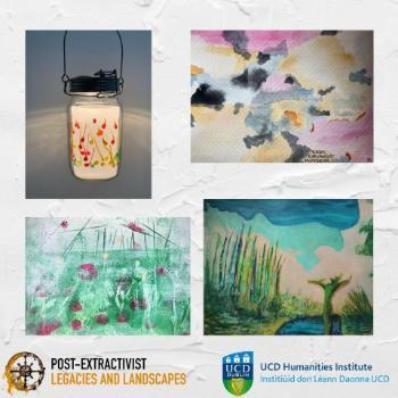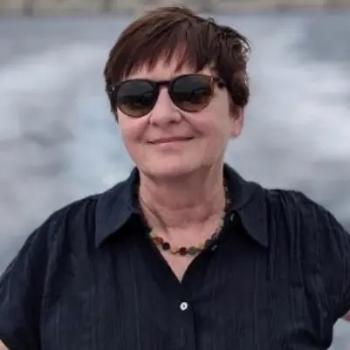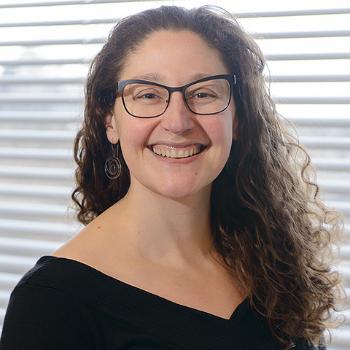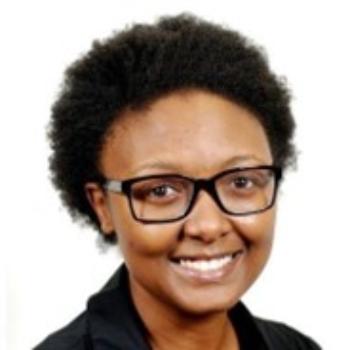Artist’s Statement | Judy Carroll Deeley | @judy.carroll.deeley-350x422.jpg)
My current work is a series of paintings titled Capitalocene: From a time of Ambition. This on-going work was initially inspired by visits to the worked-out landscape of Tynagh Mine, Co.Galway, in the 1980s. As main project artist on the international study ‘Post-extractivist Legacies and Landscapes: Humanities, Artistic and Activist Responses’ – in collaboration with UCD Humanities Institute – I had the opportunity to visit mine sites in Ireland, Estonia, and South Africa, research their impact, and respond by painting the effects of extractivist practices on the landscape.
There were three research trips in all, the most recent to the Gauteng Province of South Africa in November 2023. Here I responded to the legacy of gold mining in Gauteng Province. The area around Johannesburg is pitted by underground mines, some of which are flooded and leak toxic minerals into waterways and rivers.
The tailings ponds, which contain toxic mineral residues, are being piped to an area away from Johannesburg. Toxic leakage persists, however, for local communities. Poison dust blows over the land.
In visiting the Gauteng mine, I had a sense of how to catch the heat and dust and alluring but poisonous atmosphere through the use of rich bright colours.
In July 2023, our team, a group of academics from Tallinn University, Rice University, Australia National University, and Witwatersrand University, visited the Miners’ Village at Glendalough, with industrial historians acting as our guides. Industrial heritage is an integral part of the history of place in Ireland, but – as in the historic mine-lands of Glendalough and Glendasan – it has been overlooked.
As Irish children immersed in stories and myths about Saint Kevin and his monastic settlement at Glendalough, it became difficult for us later to identify this landscape as other than spiritual. My response was to represent mining structures on the picture postcard views of Glendalough, so endeared to generations of Irish at home and abroad, in order to remind people of its mining heritage.
On a recent hike to the mine site in Glendasan Valley I experienced something of an epiphany. Right next to the mining detritus was a rag tree and a holy well. Visions of miners’ families of old tying rags to the tree and dipping fingers in the well in supplication to Saint Kevin for the safe return of their loved ones deep in the mines below flashed before my eyes – the sacred and the secular in perfect harmony.
In my forthcoming solo show in Mermaid Arts Centre Bray in 2025, I want to respond to these juxtapositions of the spiritual and the earthly, the pastural and the industrial, in large-scale oil paintings. My hope is that this exhibition will contribute to the sense of Glendalough as a place of labour and of prayer, and to the sense that the heritages of mining and monasticism in Glendalough do not have to be mutually exclusive.
In April 2023, my first research trip with UCD Humanities Institute and the Study participants was to the oil-shale mining district of Ida-Virumaa in Estonia. This blanched countryside is smothered by mounds of ash. I was taken by the ‘ghost-thing’ inherent in the Ida-Virumaa landscape. There are bleached hills, blanched roads and empty abandoned towns, the legacy of oil-shale mining in the area. This territory is no longer suitable for agriculture. Layers of trees and soil metres deep were removed to make way for the mines. Any remaining trees cling to an uncertain earth. It has an eerie artificial beauty that I tried to express in my Ida-Virumaa paintings.
Following all three research trips, I returned to my studio and prepared compositions for paintings from photographs but mostly from my mind’s eye. These compositions convey a sense of the lived experience and the conjured ‘emotion’. I then worked in oils on canvas. Each painting attempts to find a balance between the eerie beauty of the mine lands and the damage they do to the environment.


 on representations of singleness, domestic architecture, and emotional responses to occupancy, aging and ability.
on representations of singleness, domestic architecture, and emotional responses to occupancy, aging and ability.  of mineral mining on the nineteenth-century literary cultures of Australia, New Zealand and South Africa. At UCD she lectures on nineteenth-century literature, settler colonial literature, and the economic humanities.
of mineral mining on the nineteenth-century literary cultures of Australia, New Zealand and South Africa. At UCD she lectures on nineteenth-century literature, settler colonial literature, and the economic humanities. of bioarcheology and archival research to shed light on the marginalized people from the South Africa’s colonial period. Her work focuses on the migration and diet of enslaved persons at the colonial Cape and workers’ migration to the gold and diamond mines during South Africa’s mineral revolution. She applies isotope geochemistry to skeletal material and interrogates written records to elucidate individual histories. By studying labour migration and diet over 170 years (1750-1920) of South Africa’s history, she aims to assess whether and to what extent the migrant labour system is part of a continuum that began with the shipment of enslaved people to the Cape. She writes transnational history that spans the early modern and modern periods.
of bioarcheology and archival research to shed light on the marginalized people from the South Africa’s colonial period. Her work focuses on the migration and diet of enslaved persons at the colonial Cape and workers’ migration to the gold and diamond mines during South Africa’s mineral revolution. She applies isotope geochemistry to skeletal material and interrogates written records to elucidate individual histories. By studying labour migration and diet over 170 years (1750-1920) of South Africa’s history, she aims to assess whether and to what extent the migrant labour system is part of a continuum that began with the shipment of enslaved people to the Cape. She writes transnational history that spans the early modern and modern periods. 



